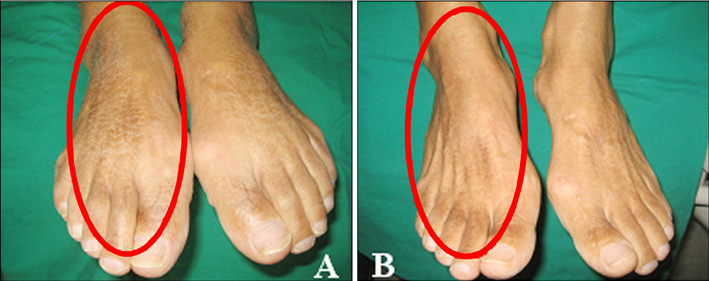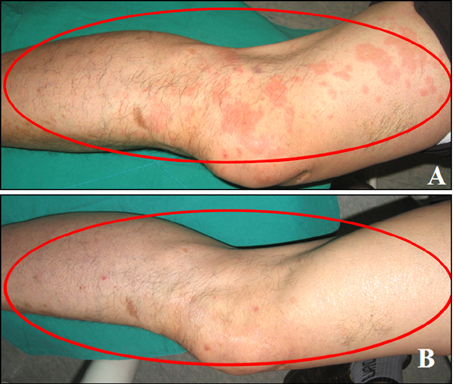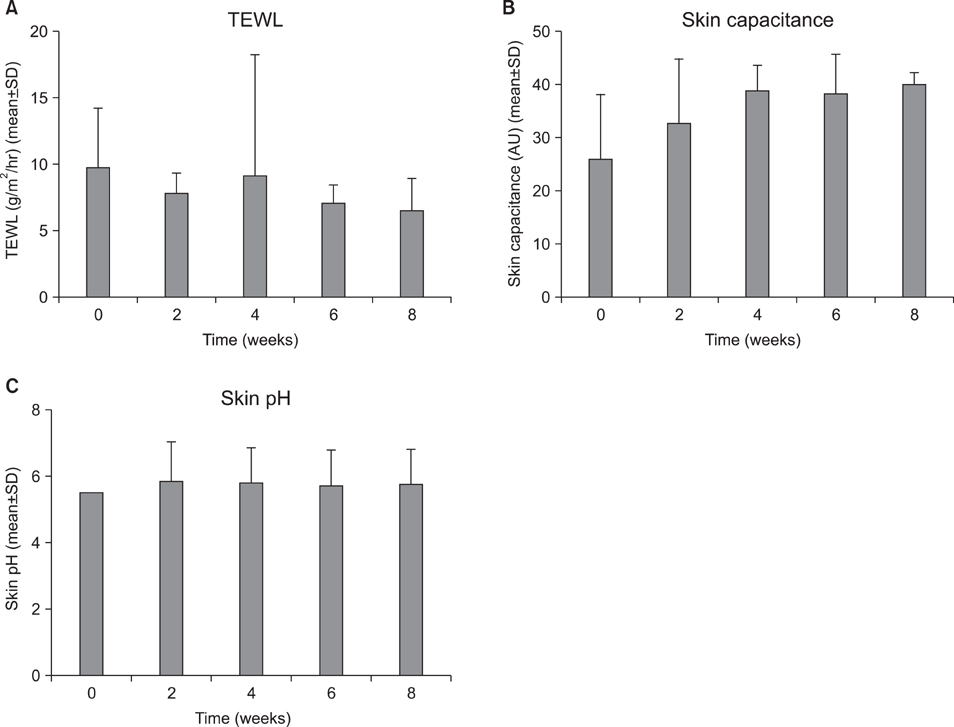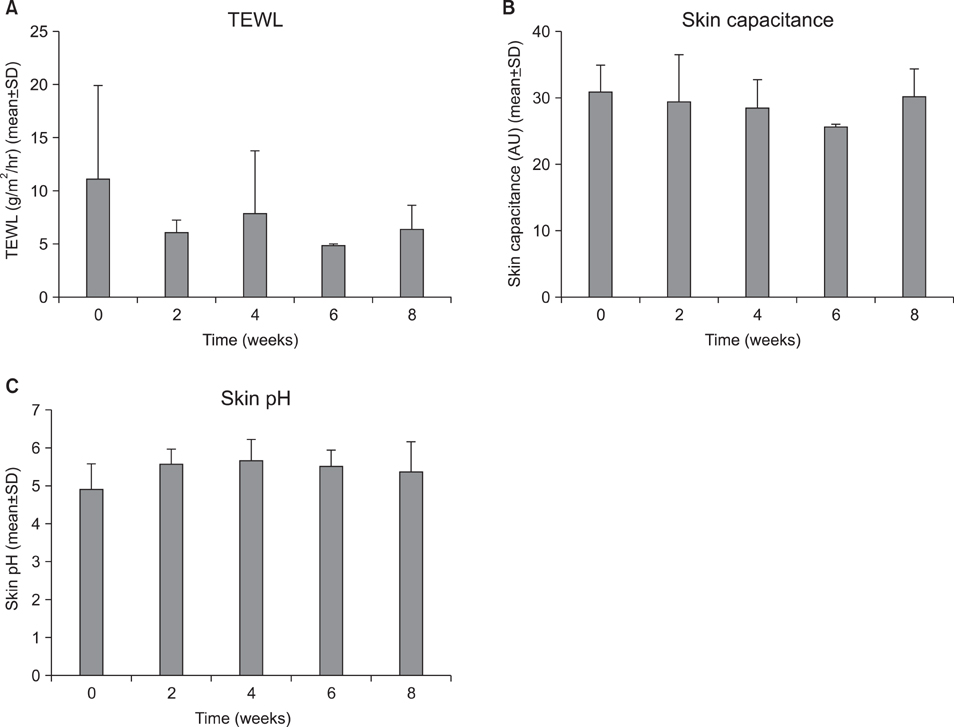Ann Dermatol.
2010 May;22(2):143-148. 10.5021/ad.2010.22.2.143.
Effectiveness of Topical Chia Seed Oil on Pruritus of End-stage Renal Disease (ESRD) Patients and Healthy Volunteers
- Affiliations
-
- 1Research Division, NeoPharm Co., Ltd., Daejeon, Korea.
- 2Department of Dermatology, Korea University College of Medicine, Ansan Hospital, Ansan, Korea. kumcihk@korea.ac.kr
- KMID: 2265383
- DOI: http://doi.org/10.5021/ad.2010.22.2.143
Abstract
- BACKGROUND
Several studies have been performed to evaluate the efficacy of dietary n-3 fatty acid for patients with renal dysfunction. While about 40% to 80% of patients with end-stage renal disease (ESRD) complain about pruritus and xerosis, there are few reports on the effects of topical n-3 fatty acid on these symptoms.
OBJECTIVE
In order to investigate the possible beneficial effects of topical n-3 fatty acid, oils extracted from chia (Salvia hispanica) seed were formulated into topical products, the effects of which were measured.
METHODS
Five healthy volunteers having xerotic pruritus symptoms and 5 patients with pruritus caused by either ESRD or diabetes were involved in this study. A topical formulation containing 4% chia seed oils were applied for an 8-week duration. Subjective itching symptoms were assessed on a 6-point scale, as were other skin functions, namely transepidermal water loss and skin capacitance. RESULTS: After the 8 weeks of application, significant improvements in skin hydration, lichen simplex chronicus, and prurigo nodularis were observed in all patients. A similar improvement was also observed among healthy volunteers with xerotic pruritus. Improvement of epidermal permeability barrier function and skin hydration, represented by trans-epidermal water loss and skin capacitance, respectively, were also observed. No adverse effects were observed in all the tested patients and volunteers.
CONCLUSION
Chia seed oil can be used as an adjuvant moisturizing agent for pruritic skin, including that of ESRD patients.
MeSH Terms
Figure
Reference
-
1. Chen YC, Chiu WT, Wu MS. Therapeutic effect of topical gamma-linolenic acid on refractory uremic pruritus. Am J Kidney Dis. 2006. 48:69–76.
Article2. Young AW Jr, Sweeney EW, David DS, Cheigh J, Hochgelerenl EL, Sakai S, et al. Dermatologic evaluation of pruritus in patients on hemodialysis. N Y State J Med. 1973. 73:2670–2674.3. Bourre JM. Dietary omega-3 fatty acids for women. Biomed Pharmacother. 2007. 61:105–112.
Article4. Gil A. Polyunsaturated fatty acids and inflammatory diseases. Biomed Pharmacother. 2002. 56:388–396.
Article5. Vergili-Nelsen JM. Benefits of fish oil supplementation for hemodialysis patients. J Am Diet Assoc. 2003. 103:1174–1177.
Article6. Ayerza R Jr, Coates W. Effect of dietary alpha-linolenic fatty acid derived from chia when fed as ground seed, whole seed and oil on lipid content and fatty acid composition of rat plasma. Ann Nutr Metab. 2007. 51:27–34.
Article7. Tamimi NA, Mikhail AI, Stevens PE. Role of gamma-linolenic acid in uraemic pruritus. Nephron. 1999. 83:170–171.8. Murphy M, Carmichael AJ. Renal itch. Clin Exp Dermatol. 2000. 25:103–106.
Article9. Ponticelli C, Bencini PL. Uremic pruritus: a review. Nephron. 1992. 60:1–5.
Article10. Robertson KE, Mueller BA. Uremic pruritus. Am J Health Syst Pharm. 1996. 53:2159–2170.
Article11. Andreassi M, Forleo P, Di Lorio A, Masci S, Abate G, Amerio P. Efficacy of gamma-linolenic acid in the treatment of patients with atopic dermatitis. J Int Med Res. 1997. 25:266–274.
Article
- Full Text Links
- Actions
-
Cited
- CITED
-
- Close
- Share
- Similar articles
-
- Epidermal Proteinase-Activated Receptor-2 Expression is Increased in End-Stage Renal Disease Patients with Pruritus: A Pilot Study
- Clinical approach to quality of life in children with end-stage renal disease
- Depression in Patients with End-Stage Renal Disease
- Therapeutic Consideration for the Elderly Patients with End Stage Renal Disease
- Cutaneous Manifestations in End-stage Renal Disease on Hemodialysis and Peritoneal Dialysis





